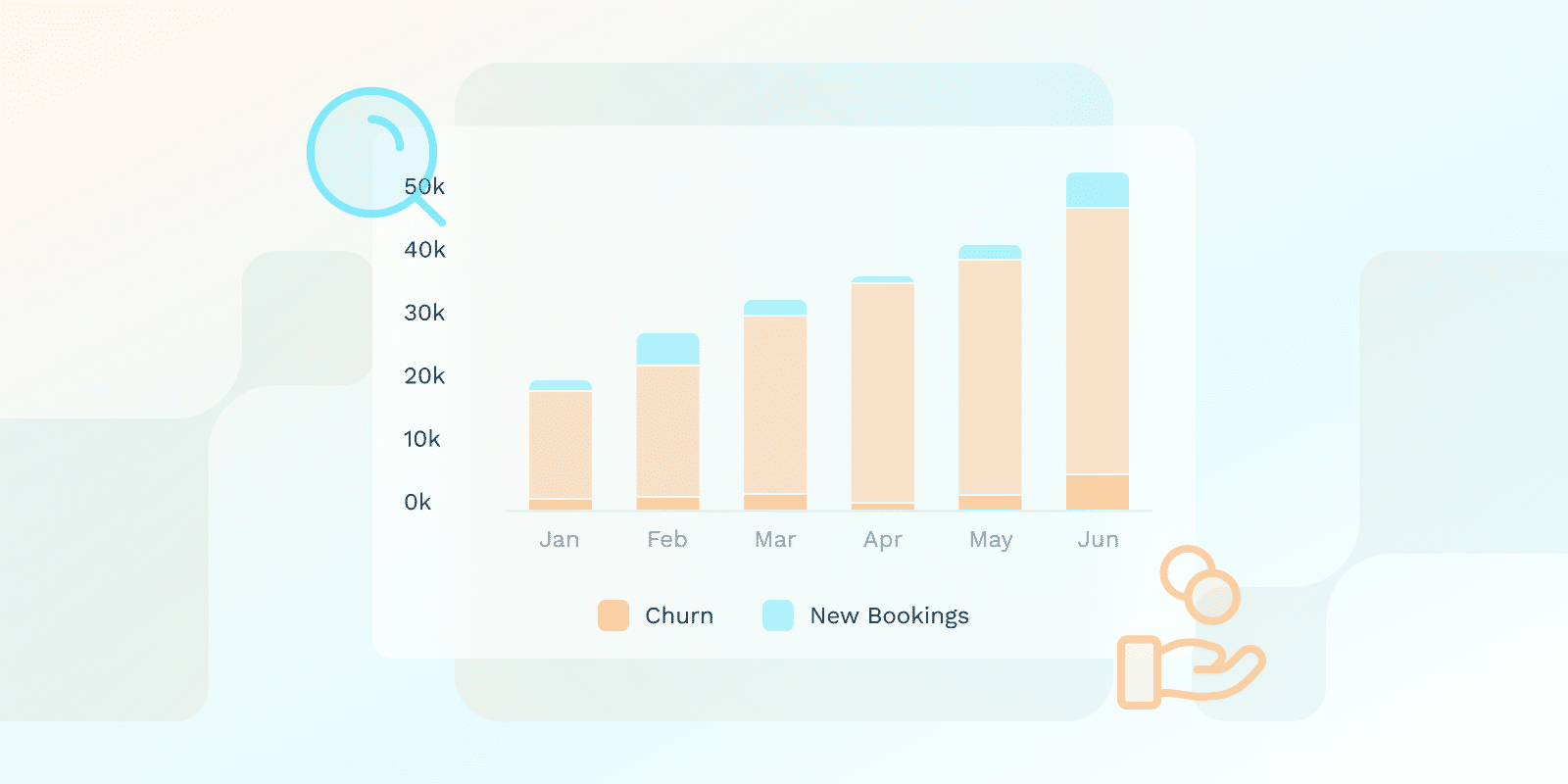SaaS-statistieken en -KPI's
Wat is Committed Monthly Recurring Revenue (CMRR)?

Wat is CMRR (Committed Monthly Recurring Revenue)?
CMRR toont de uitgaven van organisaties in relatie tot investeringen, beschikbaarheid van middelen en personeelsquota. Daarentegen houdt de omzet via abonnementen alleen rekening met boekingen en churn.
Door CMRR te gebruiken binnen een SaaS-omgeving, kunnen bedrijven hun toekomstige inkomsten schatten op basis van hun contractuele terugkerende inkomstenverplichtingen.
Houd er rekening mee dat: CMRR is een rapport voor de toekomst, dus het komt niet overeen met de werkelijke inkomstenontvangsten.
Wat is het verschil tussen CMRR en MRR?
CMRR en MRR zijn prestatie-indicatoren voor SaaS-bedrijven.
MRR (maandelijks terugkerende omzet) is de omzet die is opgebouwd uit actieve abonnementen in de afgelopen 30 dagen, terwijl CMRR naar de toekomst kijkt.
De CMRR-formule omvat MRR en anticipeert op verschillende mogelijke uitkomsten, waaronder het afhaken van abonnees, planaanpassingen en wijzigingen in betaalde abonnementen, waardoor een uitgebreid perspectief wordt geboden.
De verwachte opzegging van abonnementen versterkt CMRR, omdat het meer inzicht geeft in het operationele vermogen dan MRR, dat een beperkt zicht heeft.
De formule voor het berekenen van CMRR is: Eind CMRR = Begin CMRR + Nieuwe boekingen CMRR + Uitbreiding CMRR – Verloren CMRR.
| Functie | CMRR (Toegezegde maandelijkse terugkerende inkomsten) | MRR (Maandelijkse Terugkerende Inkomsten) |
|---|---|---|
| Tijdsperspectief | ||
| Tijdsfocus | Toekomstgericht, voorspellend | Terugblikkend, retrospectief |
| Berekeningsperiode | Anticipeert op toekomstige omzetverplichtingen | Weerspiegelt de omzet van de afgelopen 30 dagen |
| Omzetberekening | ||
| Berekeningscomponenten | Inclusief nieuwe boekingen, uitbreidingen en verwacht verloop | Alleen gebaseerd op actieve abonnementen |
| complexiteit | Uitgebreider, houdt rekening met potentiële veranderingen | Eenvoudiger, momentopname van huidige abonnementen |
| Bedrijfsinzichten | ||
| Strategische Waarde | Biedt gedetailleerde prognoses voor strategische planning | Biedt een momentopname van de huidige omzetprestaties |
| Overweging van verloop | Houdt expliciet rekening met mogelijke annuleringen van abonnees | Houdt geen directe rekening met mogelijk toekomstig verloop |
Wat zijn de belangrijkste voordelen van het gebruik van CMRR?
Het verzamelen van gegevens over CMRR (Committed Monthly Recurring Revenue) kan relevant zijn voor het nemen van strategische beslissingen over groei en investeringen.
Omzetvoorspelling biedt inzichten voor strategische budgettoewijzing en middelenverdeling op basis van verwachte toekomstige behoeften.
CMRR is met name relevant voor bedrijven met terugkerende abonnementen, omdat het terugkerende inkomsten en algemene financiële prestaties voorspelt. Het biedt ook:
- De prognose van maandelijks terugkerende omzet (MRR) wordt verfijnd door rekening te houden met toekomstige krimp en upsells.
- Biedt een volledige uitsplitsing van de totale verwachte kasstromen, inclusief kasstromen van toekomstige nieuwe klantenacquisitie en het mogelijke verlies van enkele klanten.
- Pak klantverloop aan door vroegtijdige voorspelling van mogelijke churn.
- Toont nadruk op het boeken van nieuwe zaken, omdat churn kan worden aangezien voor bedrijven met kortere verkoopcycli.
Hoe kunnen bedrijven CMRR verhogen?
Bedrijven kunnen CMRR mogelijk beïnvloeden door strategieën te verbeteren Klantbehoud, mogelijk het verlies van klanten te beperken en te promoten upsells. Het is essentieel om de drijfveren van CMRR te bepalen door churn, upgrades of downgrades te identificeren en abonnementsservices te verbeteren.
In termen van geboekte maandelijkse contractinkomsten en geplande contractwijzigingen is CMRR ook gewijzigd, dus verbetering in deze richting zal ook CMRR maximaliseren.
Bedrijven moeten maatregelen nemen om de klantenbinding te verbeteren door rekening te houden met verwachte churn in CMRR-berekeningen.
Wat wordt beschouwd als een goede CMRR voor een SaaS-modelbedrijf?
Voor een SaaS-bedrijf toont een goede CMRR groei en stabiliteit. Hoewel er geen magisch getal is dat op alle situaties van toepassing is, is bij het rapporteren van CMRR een nettowinst in abonnementen en een groeiende CMRR gebruikelijk.
Houd er rekening mee dat de relatie tussen CMRR en de groeiresultaten van een SaaS-bedrijf kan worden beïnvloed door verschillende factoren, waaronder een gunstige CMRR.
- Een CMRR is een waardevolle metriek voor SaaS-bedrijven die op zoek zijn naar financiering en investeerders, omdat het de mogelijkheid van het bedrijf weerspiegelt om effectief inkomsten te genereren en zijn kosten te dekken.
- Een hoge CMRR geeft aan dat de kans groot is dat een SaaS-bedrijf toekomstige zakelijke kansen zal veiligstellen, hoewel andere factoren de uitkomst kunnen beïnvloeden.
- De relatie tussen het verminderen van churn en de groei van de markt is ingewikkeld en een verminderde churn kan een bijdragende factor zijn die de uitbreiding van de markt kan beïnvloeden.
- Hoewel een hoge CMRR vaak wordt geassocieerd met een gunstiger financieringsomgeving, sluit een lage CMRR een SaaS-bedrijf niet automatisch uit van het verkrijgen van financiering.
Welke methode gebruiken bedrijven om CMRR-gegevens bij te houden?
De logica voor het bijhouden van CMRR-gegevens omvat de werkelijke MRR voor een maandperiode plus de huidige cumulatieve boekingen en churn-gegevens. Deze methode houdt in dat alle onregelmatige boekingsorders, wijzigingen in contracten die in schema's worden weergegeven, worden geregistreerd en dat de omzet elke maand wordt gepland.
In elke organisatie moet het beheer en de berekening van CMRR het gebruik van verschillende geautomatiseerde tools en software omvatten die effectieve tracking bevorderen.
Belangrijke statistieken onder het SaaS-model zijn MRR, boekingen, annuleringen en downgrade-uitgaven, die allemaal in realtime kunnen worden gecontroleerd om CMRR te berekenen. Aangezien een abonnement niet stagneert, moeten systemen die CMRR controleren ook flexibel genoeg zijn om CMRR nauwkeurig vast te leggen.
Conclusie
Committed Monthly Recurring Revenue (CMRR) is een cruciale statistiek voor SaaS-bedrijven, die een nauwkeuriger beeld geeft van toekomstige inkomsten dan MRR door rekening te houden met churn, planaanpassingen en wijzigingen in betaalde abonnementen.
Het gebruik van CMRR kan strategische besluitvorming en toewijzing van middelen voor SaaS-bedrijven informeren door potentiële inkomsten-, kasstroom- en churnprognoses te bieden.
SaaS-bedrijven gebruiken CMRR om hun activiteiten, klantrelaties en financieringsstructuur te analyseren om gebieden te identificeren die verband houden met het bereiken van duurzame groei.